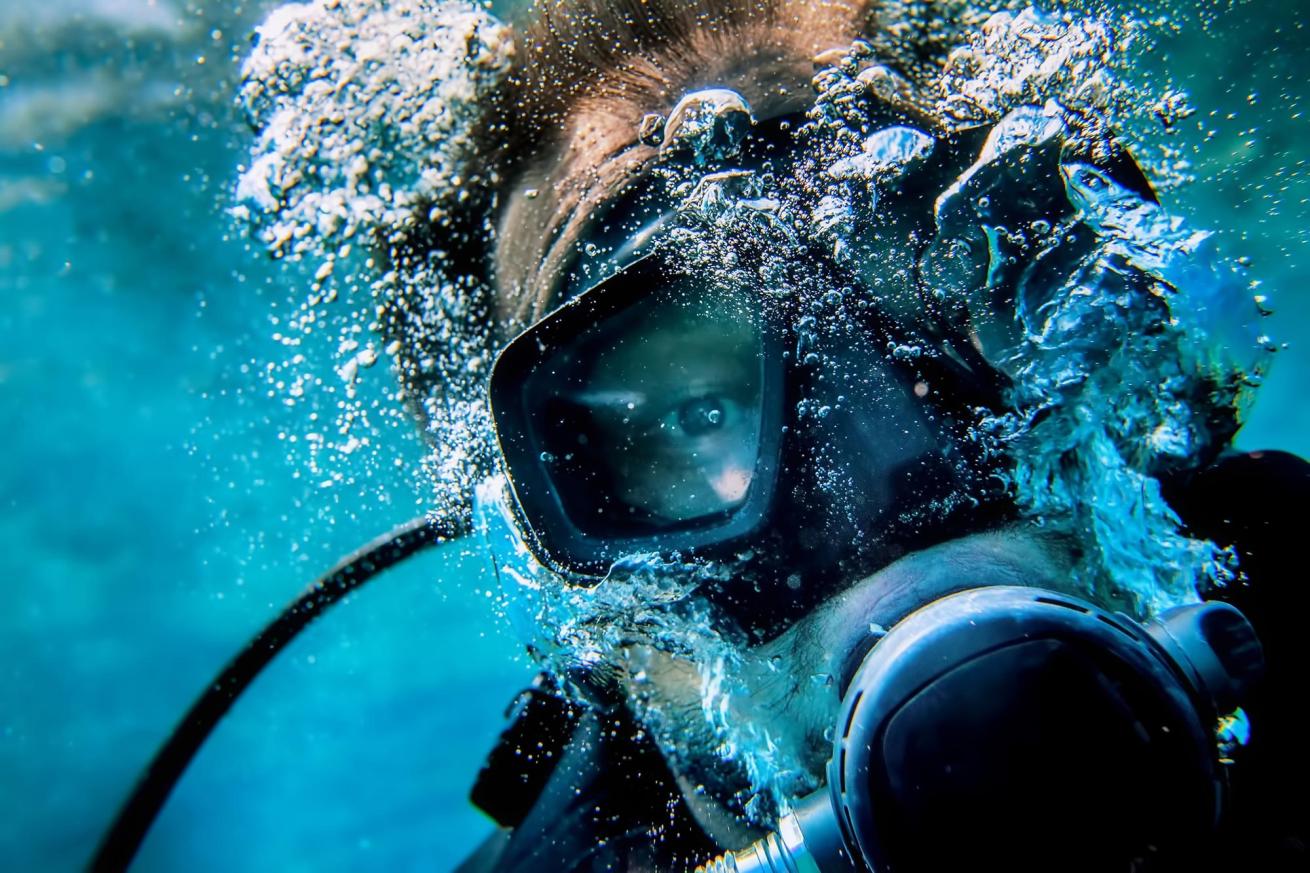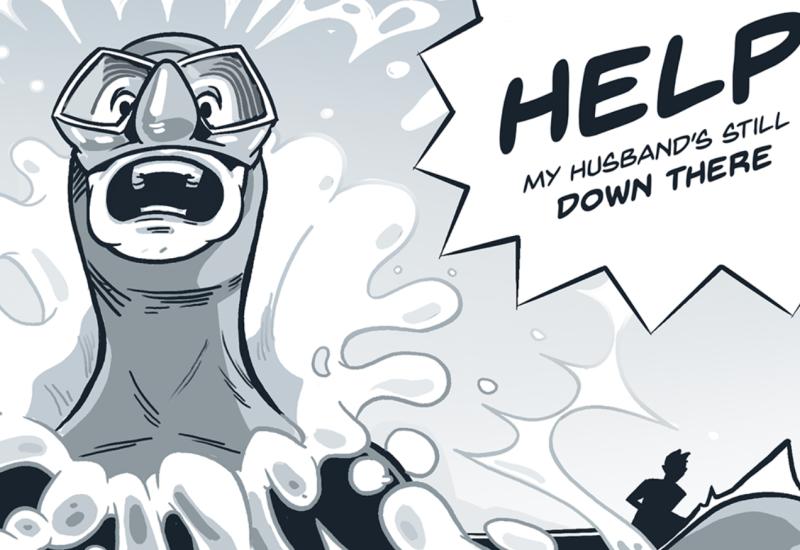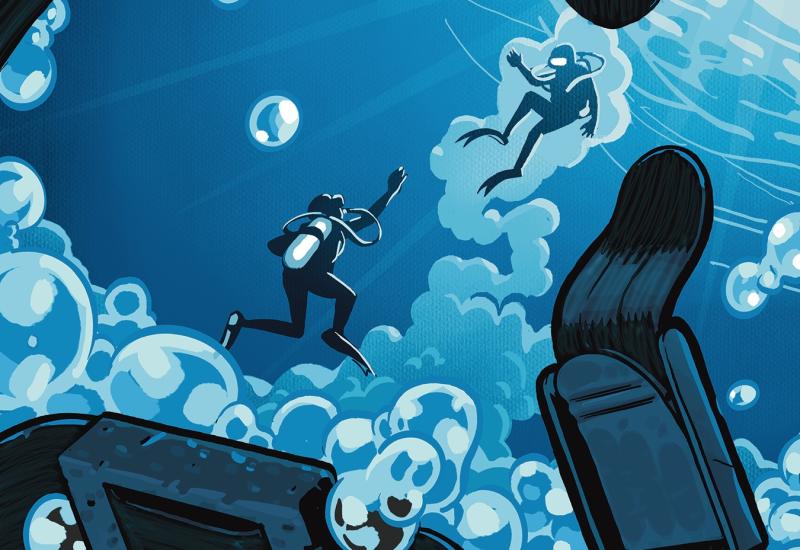Head Case
June 2007

Jesse struggled to remain conscious and hold his regulator in his mouth. There was blood in the water around him, and he felt trapped and unable to move. The pain in his head was blinding, his stomach churned with nausea and he sensed he was on the verge of passing out. What he didn't understand was how he ended up like this. Just moments ago, the dive had seemed perfect. He had begun his ascent from the beautiful reef below with plenty of air, more than 10 minutes of no-deco time remaining and his buddy just an arm's length away. Then everything was a blank. Knowing he would drown if he could not stay alert, he concentrated on breathing as he tried to remember what had happened.
The Diver
Jesse was an active, healthy diver who had recently completed his Open-Water certification and gone on to log several dozen dives. Although still somewhat new to diving, by most accounts he possessed good water skills and had a desire to learn more about the sport.
The Dive
It was a reasonably calm day when Jesse boarded the dive boat for a trip to one of his favorite sites, a healthy reef that was teeming with a diverse array of marine life. The divers listened carefully to the briefing and entered the ocean that was topped by three-foot swells. Jesse and his buddy started the dive by swimming upstream against a gentle current, exploring the reef as they went. Twenty minutes into their dive, and after using nearly a third of their gas supply, the divers turned back toward the boat and allowed the gentle current to sweep them along the reef. It had been an absolutely perfect dive, and Jesse and his buddy continued toward the mooring line.
The Accident
Both divers checked their gauges as they began their ascent and found everything to be in the green. Without a care in the world, they started a gentle drift to the surface. Jesse was attempting to give his buddy an animated example of some of the marine life they had seen on the bottom as they began rising through the water column. Soon, he was moving toward the surface at a much faster rate than his buddy. Jim tried to signal him to dump the air out of his BC, but Jesse was now engrossed in examining a small barracuda that was slowly circling their position. Jesse was in a runaway ascent and it appears that he never even realized it until his head struck the bottom of the dive boat. Jim watched helplessly as his dive partner slammed into the hull and was horrified to see a cloud of blood forming in the water around Jesse.
The Rescue
Although stunned, Jesse had the presence of mind to retain his regulator. When Jim reached his injured friend, he was relieved to find him still breathing. He also found that Jesse's fully inflated BC was holding the injured diver trapped beneath the hull. Jim deflated the BC to sink his buddy below the boat and resurfaced with him at the swim platform where his call for help was immediately answered by the alert divemaster on deck. Jesse was dazed and unresponsive as they pulled him onboard. He had an obvious head injury, but due to Jesse's rapid and uncontrolled ascent, the boat captain also feared a possible air embolism or case of DCS. The crew administered emergency oxygen and transported Jesse to the nearest medical facility where he was treated for severe head trauma, but cleared of any pressure-related injury.
Analysis
Jesse failed to realize that the laws of physics, specifically Boyle's Law regarding expanding gases, apply to every dive, even the ones in pristine conditions where everything goes right. This accident resulted clearly and obviously from three errors. First, Jesse failed to look up to see where he was going as he ascended. Second, he failed to monitor his rate of ascent on his dive computer. Finally, he failed to deflate his BC in order to control his rate of ascent. Every training agency in the world considers these three skills critical, and there is little doubt that Jesse had been trained on how to complete them. Most agencies also teach divers to reach up with their free hand in order to protect their head from unseen obstacles. Had Jesse used this procedure, he would have reduced the severity of his injuries or even avoided serious injury altogether.
A contributing cause of this accident was complacency. Cave divers have a saying: "On a good day, cave diving can be deceptively easy." It means that when everything goes right, divers sometimes think the rules no longer apply. Unfortunately, this attitude frequently results in tragedy, as it did for Jesse. Everything had gone so well on his dive that Jesse apparently felt safe enough to ignore the techniques he had learned in Open-Water certification, and his complacency nearly killed him.
Lessons for Life
Look up, reach up and rotate as you ascend, so you can see and avoid hazards.
Monitor your ascent rate. There are many hazards associated with rapid ascents including increased risk of air embolism or decompression sickness. Watch your computer or gauges — safe ascents are often slower than most divers imagine.
Vent your BC as you ascend. Keep your ascent rate under control by remaining almost neutral throughout your journey to the surface.
Always follow your training. Safe diving techniques may seem ridiculous when the dive and the conditions are perfect, but as this case shows, the rules exist for a reason.
June 2007

Jesse struggled to remain conscious and hold his regulator in his mouth. There was blood in the water around him, and he felt trapped and unable to move. The pain in his head was blinding, his stomach churned with nausea and he sensed he was on the verge of passing out. What he didn't understand was how he ended up like this. Just moments ago, the dive had seemed perfect. He had begun his ascent from the beautiful reef below with plenty of air, more than 10 minutes of no-deco time remaining and his buddy just an arm's length away. Then everything was a blank. Knowing he would drown if he could not stay alert, he concentrated on breathing as he tried to remember what had happened.
The Diver
Jesse was an active, healthy diver who had recently completed his Open-Water certification and gone on to log several dozen dives. Although still somewhat new to diving, by most accounts he possessed good water skills and had a desire to learn more about the sport.
The Dive
It was a reasonably calm day when Jesse boarded the dive boat for a trip to one of his favorite sites, a healthy reef that was teeming with a diverse array of marine life. The divers listened carefully to the briefing and entered the ocean that was topped by three-foot swells. Jesse and his buddy started the dive by swimming upstream against a gentle current, exploring the reef as they went. Twenty minutes into their dive, and after using nearly a third of their gas supply, the divers turned back toward the boat and allowed the gentle current to sweep them along the reef. It had been an absolutely perfect dive, and Jesse and his buddy continued toward the mooring line.
The Accident
Both divers checked their gauges as they began their ascent and found everything to be in the green. Without a care in the world, they started a gentle drift to the surface. Jesse was attempting to give his buddy an animated example of some of the marine life they had seen on the bottom as they began rising through the water column. Soon, he was moving toward the surface at a much faster rate than his buddy. Jim tried to signal him to dump the air out of his BC, but Jesse was now engrossed in examining a small barracuda that was slowly circling their position. Jesse was in a runaway ascent and it appears that he never even realized it until his head struck the bottom of the dive boat. Jim watched helplessly as his dive partner slammed into the hull and was horrified to see a cloud of blood forming in the water around Jesse.
The Rescue
Although stunned, Jesse had the presence of mind to retain his regulator. When Jim reached his injured friend, he was relieved to find him still breathing. He also found that Jesse's fully inflated BC was holding the injured diver trapped beneath the hull. Jim deflated the BC to sink his buddy below the boat and resurfaced with him at the swim platform where his call for help was immediately answered by the alert divemaster on deck. Jesse was dazed and unresponsive as they pulled him onboard. He had an obvious head injury, but due to Jesse's rapid and uncontrolled ascent, the boat captain also feared a possible air embolism or case of DCS. The crew administered emergency oxygen and transported Jesse to the nearest medical facility where he was treated for severe head trauma, but cleared of any pressure-related injury.
Analysis
Jesse failed to realize that the laws of physics, specifically Boyle's Law regarding expanding gases, apply to every dive, even the ones in pristine conditions where everything goes right. This accident resulted clearly and obviously from three errors. First, Jesse failed to look up to see where he was going as he ascended. Second, he failed to monitor his rate of ascent on his dive computer. Finally, he failed to deflate his BC in order to control his rate of ascent. Every training agency in the world considers these three skills critical, and there is little doubt that Jesse had been trained on how to complete them. Most agencies also teach divers to reach up with their free hand in order to protect their head from unseen obstacles. Had Jesse used this procedure, he would have reduced the severity of his injuries or even avoided serious injury altogether.
A contributing cause of this accident was complacency. Cave divers have a saying: "On a good day, cave diving can be deceptively easy." It means that when everything goes right, divers sometimes think the rules no longer apply. Unfortunately, this attitude frequently results in tragedy, as it did for Jesse. Everything had gone so well on his dive that Jesse apparently felt safe enough to ignore the techniques he had learned in Open-Water certification, and his complacency nearly killed him.
Lessons for Life
Look up, reach up and rotate as you ascend, so you can see and avoid hazards.
Monitor your ascent rate. There are many hazards associated with rapid ascents including increased risk of air embolism or decompression sickness. Watch your computer or gauges — safe ascents are often slower than most divers imagine.
Vent your BC as you ascend. Keep your ascent rate under control by remaining almost neutral throughout your journey to the surface.
Always follow your training. Safe diving techniques may seem ridiculous when the dive and the conditions are perfect, but as this case shows, the rules exist for a reason.










